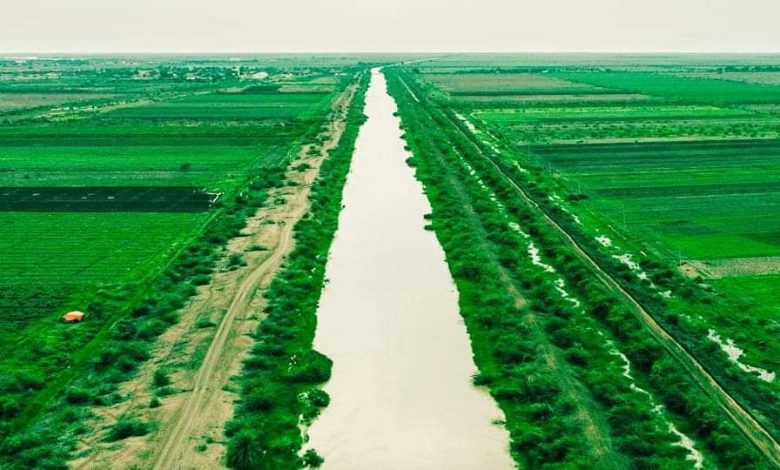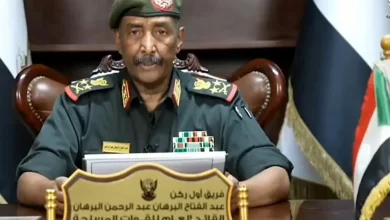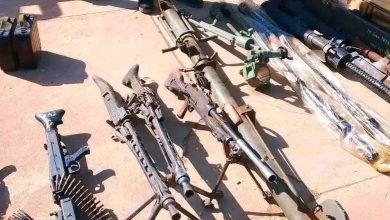Reports
A Journey Through Sudan: The Agricultural Season Amidst the Clutches of War

Sudan Events – Agencies
Sudan stands on the brink of one of the most severe food crises in its modern history. Agriculture, once the backbone of Sudan’s food security, is now severely threatened. The country relies on its local production of grains like sorghum, millet, and some wheat to meet about two-thirds of its consumption. However, armed conflict has hindered production in many areas, especially in Darfur, Kordofan, and Al-Jazirah. In these historically grain-producing regions, farmers are unable to access their fields due to violence and insecurity.
In Darfur, attacks by the Rapid Support Forces (RSF) and allied militias have targeted farmers to evacuate the lands and prevent these communities from returning. Internally displaced persons (IDPs) in Darfur camps are regularly prevented from leaving the camps to work on their fields, leading to expectations of a significant decline in agricultural output compared to previous years.
In Al-Jazirah State, which was once Sudan’s food basket thanks to one of the largest irrigation systems in the world, agricultural activities have been widely affected after the RSF took control of the region in December 2023. Al-Jazirah used to contribute around 42% of Sudan’s wheat production before the war and was a major hub for the country’s grain storage. With the escalation of fighting, farmers’ ability to cultivate their lands or access loans to buy agricultural supplies has diminished, as vast parts of Khartoum, a key hub for the country’s financial sector, have been destroyed.
In the mechanized farming areas of eastern and northern Sudan, farmers face difficulties obtaining financing and fuel, both critical factors for purchasing seeds, fertilizers, and operating farming machinery. In the north, farmers struggle to find labor due to intensive recruitment campaigns launched by the Sudanese Armed Forces. Additionally, agricultural pest control services have stopped, directly impacting productivity. Beyond human factors, unfavorable rains in some areas have further exacerbated the agricultural crisis.
Harvest forecasts for the 2023-2024 season indicate a significant decline in grain production. The Food and Agriculture Organization (FAO) estimated that sorghum yields will be 24% lower, and millet yields 50% lower than in 2022. The RSF’s control over large parts of Al-Jazirah State has severely impacted the planting of winter wheat, making the country’s food situation increasingly dire.
The war’s impact has not been limited to agricultural production; it has also led to the closure of many food processing facilities. With most food industries concentrated in the capital, Khartoum, the majority of factories, including about three-quarters of Sudan’s wheat milling capacity, have ceased operations. Even if peace were to return, it could take months before these factories resume full production.
With the mass displacement to eastern and northern regions in search of work and food, the demand for agricultural labor will be limited until the next planting season in June and July 2024.
In the west and south, where traditional rain-fed agriculture prevailed before the war, farmers usually rely on family members for unpaid labor. Even in areas where security still permits farming, job opportunities remain extremely scarce. As a result, joining armed groups and militias may become one of the few ways to access food, reflecting the extent of the humanitarian catastrophe facing Sudan.
Agricultural Challenges in Sudan
Sudan heavily relies on five major irrigation projects using water from the Nile or wells, forming the strategic reserve of food grains like sorghum and millet, in addition to securing cash incomes through the export of crops like cotton, peanuts, and sesame, and meeting part of the country’s wheat needs. The largest of these projects is the Al-Jazirah project in central Sudan, the largest irrigated agricultural project in Africa, covering over 2.2 million acres and irrigated by gravity from the Blue Nile. Besides Al-Jazirah, other important projects include Suki, Wadi Halfa, Rahad, and the Tokar Delta in eastern Sudan.
Farmers in these projects rely on bank financing or partnerships with businessmen who fund all stages of the agricultural process, from providing seeds, pesticides, and fertilizers to agricultural machinery and the necessary sacks for packing crops. However, reports from the Sudanese Agricultural Bank indicate that the cultivated area it finances has shrunk by 60% compared to past years, posing a major challenge for farmers and threatening agricultural production in the country.
Challenges of the Summer Agricultural Season
The summer agricultural season in Sudan faced immense challenges, including reduced cultivated areas due to weak financing and a lack of production inputs, in addition to fuel shortages and unprecedented price hikes. The deteriorating security situation in conflict zones, particularly in Kordofan, Darfur, and Al-Jazirah, has had a severe impact on agriculture, with farmers’ lives being at risk.
For the first time in a hundred years, the Al-Jazirah project came to a halt due to the war, deepening the humanitarian crisis amid expectations of an imminent famine that could affect half of Sudan’s population.
In a press statement, Agriculture Minister Abu Bakr Omar Al-Bushra noted that the current season is facing increasing difficulties due to security instability and the challenges of delivering agricultural inputs to areas controlled by the RSF. He explained that the targeted cultivated areas have shrunk to 36 million acres compared to 60 million before the outbreak of the war, with vast regions of Darfur and parts of Al-Jazirah being lost. Nevertheless, the minister asserted that the country will not experience a famine, citing a strategic stockpile of over a million tons of sorghum, in addition to significant amounts held by citizens and traders that are difficult to quantify accurately.
In the Northern State: High Costs and Low Prices
Ahmed Abd al-Nabi, a farmer from the Northern State, shares his experience of the summer agricultural season in his region. Abd al-Nabi highlights that farming varies from locality to locality, but in Halfa locality, the farmers’ experience is similar regarding the types of crops they grow, such as Egyptian beans, wheat, and vegetables. He adds that Halfa administrative unit suffers from waterlogging, making farming very limited. On the other hand, the Abri administrative unit focuses on winter farming, growing simple crops in summer like vegetables, sorghum, and sesame. He notes that sesame recently grown in Sai Island is a successful new crop with good yields.
Ahmed explains that the cost of production has become very high, making it difficult for ordinary people without capital to become farmers as they did before. Therefore, farmers in the north prefer focusing on the winter season since its crops are more profitable. He elaborates that summer crops are grown in small quantities to meet household needs, while winter crops provide financial value that helps implement projects or pay off accumulated debts.
Despite the importance of the winter season, agricultural financing remains a major obstacle. Farmers often rely on loans from the Agricultural Bank, but financing comes late, negatively affecting productivity due to the delayed planting period. Farmers also struggle to repay these loans, as the bank allows a short repayment period post-harvest, during which crop prices are very low, forcing them to sell their crops at cheap prices to pay off debts.
Ahmed points out that the cost of planting Egyptian beans, for example, exceeds 380 Sudanese pounds per sack, while the selling price is only 15,000 pounds, exposing farmers to heavy losses. He adds that agriculture in the Northern State is heavily dependent on modern fertilizers and pesticides, but the lack of qualified personnel for guidance and pest management presents a major challenge, especially when pests like insects appear and destroy crops without available pesticides or proper guidance. For Ahmed, farming in the Northern State can be very successful if there is support and funding from relevant authorities. However, if the current situation continues without improvement, farmers will find themselves burdened with debts and may abandon farming altogether. He concludes, “As long as we are productive and farming, we will not starve.”
In White Nile: The Crop is Not Enough
Mohamed Yassin, a farmer from White Nile State, recounts the story of the current summer agricultural season in the Gaffa project. The cultivated area this season represents only 25% of the total project area due to high fuel prices and the difficulty of obtaining it, in addition to deteriorating security conditions.
In the area under Sennar’s jurisdiction, the army has prohibited farming in Jebel Moya and Jebel Mir due to RSF control, preventing shepherds or farmers from accessing these areas for fear of their safety. Even in areas where farming is allowed, farmers have been restricted to working during daylight hours only and prohibited from using engines at night to avoid being mistaken for RSF forces. Mohamed explained that someone who used to plant thirty feddans (five acres) in the past was only able to plant two or three this year.
The main crops in the Gaffa project include sorghum, which is the staple food for the people of White Nile, in addition to millet. Yassin also mentions that sesame was planted in limited quantities due to the delayed rainy season, which started in August, affecting the crop’s success.
Mohamed highlights that government support has declined this year; in the past, the government provided seeds for free or at symbolic prices and distributed them to villages through local leaders, but this year, none of those seeds have been delivered. Government fuel support has also shrunk to only 10% and is now offered at commercial prices and arrives late, further delaying planting. Yassin adds that farmers are now afraid that clashes might prevent them from harvesting their crops after all the effort. As a result, farming this season has been limited to small quantities that barely meet the needs of farming families. He notes that other large projects in White Nile State, such as the Meginis and Jebelain projects, which used to feed Sudan with sorghum, have seen a significant decline in farming due to fuel shortages and security complications.
Concluding his statement, Mohamed expresses pessimism about this year’s sorghum production, doubting that the harvest from the Gaffa project will be sufficient to cover the needs of White Nile State, let alone provide exports outside the state as was common before the outbreak of the war.
**Kordofan and Darfur: Local
Kordofan and Darfur: Localities Out of the Season
Hassan Al-Dai, a farmer from South Kordofan, describes the agricultural situation in his area, stating that agriculture is the backbone of people’s lives, being their primary source of income. He notes that the three Kordofan states and the five Darfur states are severely affected; Darfur has been entirely excluded from farming due to the war, and the cultivated areas in North and West Kordofan have been significantly reduced. As for South Kordofan, it remains an agricultural state, known for crops like sorghum, peanuts, hibiscus, and maize. However, the war has cast a heavy shadow over agricultural production.
Hassan explains that South Kordofan consists of 18 localities, three of which are out of the agricultural process due to the control of the Sudan People’s Liberation Movement, while the remaining localities suffer from the effects of the war. For example, the Habila locality, which had the highest production, has lost most of its cultivated areas this season due to the triple conflict between the Sudan People’s Liberation Movement, the army, and the RSF. Similarly, Al-Qoz locality is under RSF control, and Al-Ashia locality has been severely damaged, with only 20% of its areas cultivated.
Hassan outlines the impact of the war on other localities such as Al-Tadamun and Abu Jubeiha: the former was partially affected by the conflict, while the latter continued production but at lower quantities than before. He also points out that the cultivated areas within the Al-Tadamun locality’s plan have shrunk to only 20,000 acres out of 600,000, while areas outside the plan—about 400,000 acres owned by small-scale farmers—were affected by rising production costs like fuel and pesticides, which have reached unprecedented prices, making farming a major challenge.
The bank financing that was previously provided by the Agricultural Bank before the war has only added to the difficulties for farmers. Hassan concludes that the agricultural situation in western Sudan is catastrophic: cultivated areas have decreased by 80% in North and West Kordofan, and in South Kordofan, only 10% of the land is cultivated, while the region faces a huge influx of displaced people, increasing the pressure on local resources.
Speaking to “Atara,” Hassan Ahmed Mohammed Mutar, a representative of West Darfur’s farmers, highlighted an initiative by the state’s government that led to the formation of a high committee to oversee the agricultural season. The committee began its work in May, before the rainy season, and divided tasks among localities and administrative units. Hassan describes this experience as successful; after visiting farmers, they found that citizens had carried out the agricultural processes perfectly.
Hassan emphasized that efforts are now focused on securing the agricultural season to ensure a successful harvest. He called on herders to be patient and cooperate, noting that the harvest is not only for farmers or herders but is a gain for all residents of the state and a significant boost to the region’s economy.
Eastern Sudan: High Productivity and Obstacles
The state of Al-Qadarif in eastern Sudan is among the most involved in agricultural activities during the current summer season, particularly after the states of the Red Sea and Kassala were struck by floods and heavy rains that negatively affected agriculture there. According to “Sudan Tribune,” the harvesting of sesame, planted over 1.2 million acres in Al-Qadarif, has begun amidst challenges, including labor shortages and high packaging material prices.
Al-Qadarif has planted 9.5 million acres of various crops this summer season, the largest area ever planted in the state, due to the influx of dozens of farmers from active conflict zones.
Ahmed Babakr Shula, a member of the steering committee for Al-Qadarif’s farmers, mentioned that “the sesame harvest, which is expected to yield high productivity, faces complexities and challenges.”
He pointed out that the first challenge is the closure of the Gallabat crossing between Sudan and Ethiopia due to the conflict between the federal army and the “Fano” militias, making it difficult to bring in temporary seasonal labor from Ethiopia to Al-Qadarif. Shula called on state institutions for immediate intervention by compelling banks to finance the sesame harvest operations, as well as providing sacks and equipment. He also emphasized the need to secure the harvest from theft and looting in northern and southern Al-Qadarif and to put an end to herders’ encroachments in villages and areas adjacent to Al-Qadarif, particularly in the states of Al-Jazira, Sennar, and Khartoum.
The Women of Daqway and Their Men Reclaiming the Land: Life as a Partnership
Al-Tadamun locality in South Kordofan is primarily agricultural, like most areas of South Kordofan. The majority of its residents depend on farming for their livelihood and food, with some reliance on herding. Residents cultivate in the rainy season and store their production for the rest of the year. It is bordered to the north by the White Nile state, to the south by Upper Nile state in South Sudan, to the west by Al-Abbasiya locality, and to the southwest by Abu Jubeiha locality.
According to a source who spoke to “Atara,” the cultivated area in Al-Tadamun locality is estimated at one million acres, based on data from the locality’s agricultural office. Of these, 600,000 acres are planned lands owned by traders with significant capital, most of which were cultivated in previous years. However, only 30% of this area was cultivated this year due to the war, as most farmers came from outside the state. The other 400,000 acres are outside the plan and mostly owned by local residents with limited income, half of which were cultivated this year.
Farmers faced major challenges, the first being security issues. According to one local resident, who requested anonymity, RSF forces controlling the city of Umm Ruwaba on the northwestern border of Al-Tadamun locality managed this year to enter the Umm Al-Khairat administrative unit within Al-Tadamun locality. Clashes ensued between them and the police forces, resulting in the killing of police members, and the RSF seized their weapons and vehicles, then spread out along the northern border of Kordofan to White Nile state, causing chaos. Armed individuals also seized farmers’ equipment, crops, and money, creating a state of fear that prevented other farmers from risking their lives by traveling the roads.
Another challenge is the high cost of agricultural inputs such as fuel and fertilizers, preventing most farmers in the safer areas from engaging in farming activities. The “Umm Biyud” area in Al-Tadamun locality is surrounded by hills and mountain ranges extending as far as the eye can see. This area was spared from the war that began on April 15, yet its people still suffer its consequences. The women and men in Umm Biyud, and the nearby “Daqway” area, located a half-hour walk away, await the beginning of the agricultural season, but this year is different.
Women Farmers
A harsh winter amidst the mountains and valleys is when the “Atara” reporter visited the “Daqway” area in Al-Tadamun locality, South Kordofan.
Women there are never idle, always active and cheerful about their work, rising early before sunrise. Before social visits, they fetch water from the village well, located at the edge of the village, with young girls and women carrying jerry cans on their heads twice a day. This exhausting and tedious task is followed by household chores that conclude with the early preparation of breakfast. This might include a delicious porridge with okra sauce grown by their own hardworking hands or fava beans from their fields mixed with home-made yogurt. They cook over wood fires made from branches gathered from trees growing beyond the hills.
It’s a completely self-sufficient lifestyle.
At noon, they agree to gather for coffee at one of their houses. They fill a bowl with sugar, a cup with ginger and cardamom, and another with coffee powder. They enjoy pounding the ginger, adding plenty for a sharp taste. When roasting the coffee beans, they all go quiet, enjoying the ritual, and soon the atmosphere fills with warmth. They then perform fortune-telling, eagerly awaiting the predictions that come twice a week on Mondays and Thursdays. After these joyful moments, they part ways, repeating these gatherings with unending enthusiasm.
The women speak quickly, one word following another, so much so that you almost miss what they are saying. They create songs about their loved ones and heroes, memorize them, and sing them during gatherings and leisure times. Time passes slowly, helping them appreciate life’s value and the beauty of contemplation. Women in Daqway don’t own phones, nor do most of the men, so they have no exact sense of time. There’s no mosque either, and people determine time by observing sunlight. Every minute holds significance, even if it passes slowly. When the people of Daqway visit the city of Kosti, they struggle to keep up with the fast-paced lifestyle, eventually surrendering and quickly returning to their area.
After breakfast, the men disappear from the village, heading to the market. With the men gone, the burdens disappear too, leaving the space for the women and children alone. Women and girls there love education, but societal oppression often manifests in the term “Tahjeer” (meaning prohibition). When a girl finds herself denied education, even if her father enrolls her in school, her cousin might stop her on her way. When her mother asks why she returned, she replies, “They stopped me.”
During the rainy season, the countryside comes alive as the sky shines over the fields. Fields are cultivated by the women of Daqway, from the early stages of plowing and soil preparation to the final stage of harvesting. To them, work is another form of
creativity.
The women scatter their seeds, fully aware that the sesame stalk will grow after three months, a plant that endures drought, much like their resilience in the face of hard days. Women in South Kordofan, like women throughout the region, face dual challenges related to their roles within their families and the significant risks tied to protecting their crops from pests, weeds, and climate changes. They work with immense solidarity and strength, as they rely mainly on their community’s support and, most importantly, maintain their households, particularly the kitchen, thus ensuring the continuity of their families’ lives.
For “Hajja Amina,” agriculture means everything. She wakes up early and goes to her field, tending to her crops, including okra, cowpeas, peanuts, and sesame. Amina relies entirely on the rainy season for her farming, leaving behind her restaurant in the local market, which depends on the leftover harvests from previous seasons.
When asked by the “Atara” correspondent about her work, Hawliya Saleh quickly replied, “I am a farmer.” She elaborates that farming means a lot to her; from it, she was able to build a better house, buy goats for her children, as well as sheep and cows, and even share in the ownership of half a water pump with another person—all from her annual crop returns.
Amina begins by clearing the soil of weeds before the rain starts. Then she keeps a vigilant eye on the crops, ensuring that the weeds don’t grow again and block the water from reaching deep into the soil. The second clearing, known as “Genkab,” helps increase the harvest yield.
The Beauty of Harvesting in South Kordofan
Women and girls gather, taking their provisions and coffee with them to the fields. They sing the songs they know or those they have created, harvesting their crops as they go:
“Star of the night, do not disappear
You kept watch over me
You kept watch over me
For my love
You kept watch over me.”
They work together, one following the other.
Amina explains, “When it’s harvest time, we all go. I prepare the mats and the empty sacks, take enough food, and we spend most of the day in the field. Everyone helps me with the harvest. Once the part designated for the day is completed, we return home; otherwise, we spend the night outdoors.” Not only that, but the women have established a supply cooperative—a “seasonal fund”—that holds two quintals of sesame, sacks of sorghum, some okra, and cowpeas, stored in a secret location known only to them. They draw from it in times of need, and during times of abundance, it remains until the next season, when they sell it to buy seeds for the new planting season.
The Shadows of War
Saleh Mukhtar, a farmer from Umm Biyud, says the war has severely impacted this season, leading to a frightening increase in the price of diesel, with a gallon reaching 250,000 Sudanese pounds and a barrel 3 million pounds, resulting in reduced cultivated areas. In the past, Saleh and the other farmers used to cultivate the land twice a year, but this didn’t happen this year, negatively affecting productivity. The second planting usually improves soil fertility, enhancing the growth of crops compared to the first planting and also reducing the proportion of weeds in the soil.
Al-Tahir Hamid Al-Tahir from Habila, in the Daqway area, agrees with Saleh’s account, whom “Atara” found uprooting harmful weeds in his sesame field. He stated, “I couldn’t afford to buy pesticides this year due to their high prices.”
Saleh adds that the price of a liter of pesticide last year ranged between 6,000 and 8,000 Sudanese pounds, but it has now risen to 40,000 pounds per liter, while the cost of the liter used for sesame has jumped to 120,000 pounds compared to 15,000 pounds in the previous season. The diesel price hike has also affected soil spraying with pesticides, causing most farmers to refrain from purchasing them.
When the “Atara” correspondent asked Saleh what the people of Umm Biyud would rely on if the agricultural season failed, Saleh emphasized that the area depends entirely on farming—even livestock is purchased with revenue from the harvest. He added, with a sense of sadness, “If the season fails, the situation will be worse than last year when the price of a measure of sorghum reached 10,000 pounds, and a pound of sugar cost 9,000 pounds. Such things have never happened before, not even during drought seasons. The failure of the season means a definite famine.”
Saleh and Habila agreed that the current season has been successful so far, with productivity levels between 60-65%.
Saleh mentioned that 50-60% of the land in Al-Tadamun locality and nearby localities remain uncultivated. This year, the locals themselves planted around 30%, including 20% sesame and 10% sorghum, noting that sorghum is the main crop.
The “Umm Biyud” area has received between 15,000 and 20,000 displaced people. Saleh says the displaced did not engage in farming and rely on the produce of the residents. He added that Al-Tadamun locality would need to supply about four neighboring localities whose residents did not farm this year.
Saleh states that the rains poured heavily in August, flooding a significant amount of crops and damaging them. When the soil dried, many farmers replanted, but the rains did not return for an entire month, affecting them negatively. Habila, also affected, commented, “The rains stopped during the most critical stage for the crops, the production phase, causing the loss of about 40% of the crops.”
Habila explains that the agricultural cycle begins in May, with sesame harvesting taking place around mid-November, while sorghum harvesting extends to March of the following year.
While sitting in the daylight after a long day’s work in his field, Saleh reflected on how the consequences of war, particularly the increase in diesel prices, have led to the season’s failure. He added that “the wilderness,” referring to an area used for diesel and pump storage, is constantly exposed to armed robbery.
Life as a Partnership
Amina’s father gifted her a piece of land, and her uncle gave her another. She also purchased a third plot through her independent work. Young girls in Daqway don’t own land—only married women do. Young girls assist their mothers and sisters in preparing until they reach the time for marriage, when they take part in the seasonal farming ritual. Sometimes, young girls receive small plots of land as gifts from their mothers or fathers, which they then cultivate.
Hawliya acquired her land with the money she earned from farming. Initially, she cultivated small plots until she saved enough to expand her farming operations, gradually acquiring more acres. Amina uses the profits from her harvests and her other restaurant income to educate her children. Her son Ahmed left school due to an eye condition and joined a religious school where he memorized the Quran. She is very proud of him.
Her son Mohammed earned a university degree, while her daughters completed only their basic education due to the lack of a secondary school in the area. They also have no acquaintances in the other area where they were supposed to continue their education. Her youngest son’s schooling has been interrupted due to the war.
In the early years of her marriage, Amina did not work due to raising her children, but as they grew older, she opened a coffee shop and later a restaurant. Eventually, she devoted herself to farming as a means of livelihood.
Unlike male farmers, Amina plants the fields early, ensuring the soil is ready for the first drop of rain. She cultivates okra, cowpeas, hibiscus, sorghum, and maize, in addition to her main crops—sorghum and sesame—planted later in the season.
Amina remarks, “The men just sit around while it’s us women who do all the farming. We leave the men to play dominoes in their gatherings, mocking us and calling us crazy for loving work. But, after two months, we return with our harvest on our heads, and they are stunned.” She laughs and adds, “Then they start taking from our crops.”
For Amina, farming elevates her social status as they participate in and support their community. When something needs to be done and people call upon farmers, they turn to the women. Hawliya says, “We help our men in their fields and provide for our households; life is a partnership.”



